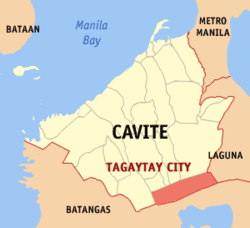
© UnknownMap of Cavite showing the location of Tagaytay.
Tagayta City, Philippines - The relocation of residents of Taal Volcano Island will take a long time to happen but this has to be given a priority since they are living in a permanent danger zone, said Celia Alba, the secretary general of the Housing and Urban Development Coordinating Council.
Alba said National Housing Authority officials have had initial discussions with municipal leaders of Talisay, Batangas for possible areas on the mainland town where the island villagers could be relocated.
However, she added that the problem with the relocation is the people themselves because the Taal residents, who are mainly fishers and farmers, do not want to leave the volcano island due to their livelihood.
"We are still on social preparation stage but we are readying the possible housing requirements in case they (villagers) are ready to be evacuated," added Alba in an interview Friday at the sideline of the Pabahay Caravan here.
Main requirementsShe added that the main requirements in setting up a relocation site are availability of land (the size would depend on how many families are affected), site development, and housing units.

© UnknownTaal Volcano
Alba said the relocation project for Taal residents would also have to be submitted to President Aquino for funding since this has not been included in the budget of NHA.
In terms of livelihood, she said the HUDCC would need to partner with the local government units for a feasibility study that would determine what jobs to provide for those who would be relocated.
Alba was in this city for the Calabarzon (Cavite, Laguna, Batangas, Rizal and Quezon) leg of the Pabahay Caravan, the third in a series of activities in line with the thrust of Vice President Jejomar Binay, the HUDCC chairman, to build stronger partnership with LGUs. The first was launched in Cebu in February then in Baguio last March.
Housing projectsBinay and other HUDCC officials have been going around the country to meet with local officials to discuss housing projects.
"We really intend to go around the nation. Hopefully by September [or] October, we have already completed meeting with local governments to inform them about the different projects of key shelter agencies (KSAs)," added Alba.
The KSAs help the LGU in preparing a comprehensive land use plan or the formulation of their local shelter plans.
For local shelter plan, the LGUs are expected to assess the housing situation, number of informal settlers and resources in terms of land and funding.
She said Binay has stressed the need for each LGU needs to have a local body that would concentrate on addressing the housing problems of their constituents.
This is particularly vital in Calabarzon, which Alba said ranked second in number of informal settlers because of its proximity to Metro Manila, which has the most number of informal settlers in the country.


Reader Comments
to our Newsletter